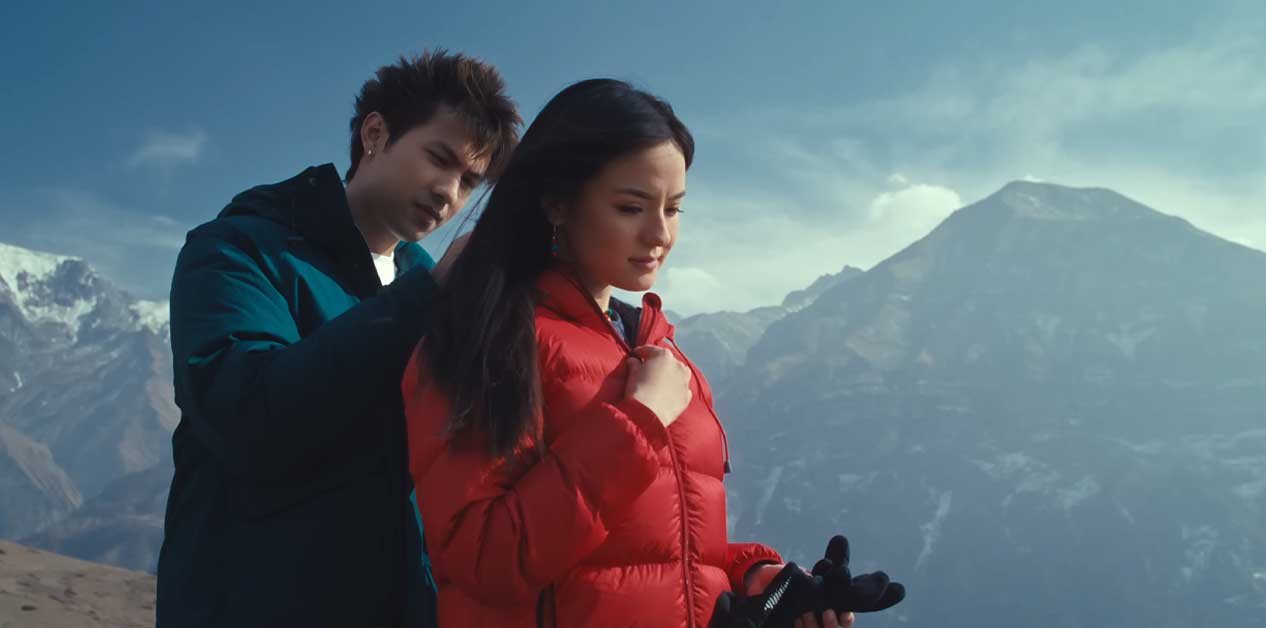

Director: Suyog Gurung
Story: Hemraj BC
Screenplay: Bishwas Timsina
Cinematography: Dulip Regmi
Editing: Nimesh Shrestha
Cast: Anmol KC, Aanchal Sharma, Jassita Gurung, Bhuwan KC, Kedar Ghimire (Magnebudha), Usha Khadgi, Suraksha Panta, and Sangita Thapa Magar.
Story/Screenplay (Score: 2.5)
Jerry (Anmol), the son of billionaire businessman Bijay Pratap Rana (Bhuwan), loses to his father in every game, including car racing, snooker, and video games. Tired of losing, one day Jerry finds out that his father had returned from Everest Base Camp without successfully summiting.
At that very moment, he decides to climb Everest to prove himself superior to his father. But, taking the decision in a fit of pique without being physically and mentally fit, he also fails, just like his father. To hide his failure, he attempts to create an illusion of having summited through Photoshop.
His lie does not last long. This brings disgrace to him and his entire family. An unexpected major crisis hits the family. To overcome the disgrace and crisis, Jerry has only one option left: to climb Mount Everest at any cost.
What is the reason Jerry must climb Everest? Will he be able to reach the summit? This is the central story of Jerry on Top. Woven into this story is a love triangle between Jerry, Shreya (Aanchal), and Pema (Jasita).
Jerry and Shreya, friends since childhood, are a couple who have decided to get married. But after meeting Pema, a guide during the Everest expedition, Jerry starts to stray. Pema is also attracted to Jerry.
As the journey of love and climbing progresses together, the lives of the film’s main and supporting characters encounter various ups and downs. To find out the conclusion of this ascent and descent, one must watch the movie.
Apart from the climbing story, the depiction of the father-son conflict and the presentation of the love story are old formulas. Despite some twists and turns, the film’s weakness is that the ending is easily predictable.
The positive aspect of the film is the conversational language used. Jerry and Shreya addressing each other with the informal ‘ta’ and the use of ‘timi’ (a more polite ‘you’) in the dialogue between Pema and Jerry both sound natural. However, the long, tedious dialogues used in some scenes occasionally become tiresome. For instance, the conversation between Jerry and Pema after being caught in an avalanche causes irritation rather than eliciting an emotional response from the audience.
Similarly, the story could have been more interesting if the antagonistic relationship between the father and son and the reason why Jerry must climb Everest had been strongly established. However, both these aspects are weak.
Acting (Score: 2.5)
Even though producers/directors have given him the ‘megastar’ tag, questions about Anmol’s acting ability have never ceased. In this film, however, he has shown a hint of improvement. But even in this movie, he has been presented more as a ‘hero’ than an actor. Jasita’s character establishment and acting are both commendable. She has won hearts in both the roles of a guide and a lover. Emotionally, the audience connects more with Jasita than with Anmol. Aanchal’s work is also improved compared to her other films. The balance among the roles of the three main characters is a positive aspect of the film.
However, Kedar’s character, playing Anmol’s maternal uncle, lacks any trace of novelty. The film would have been better without the ‘cheap comedy’ that tries to force laughter from the audience. Bhuwan’s character, playing Anmol’s father, and his acting are both just average. Usha, who plays Anmol’s mother, and Sangita, who appears as Jerry’s mother, are suitable for their roles. Suraksha’s presence on screen, though brief, might be a surprise for the audience.
Technical Aspects (Score: 2.5)
The beautiful visuals in Jerry on Top appear attractive and effective. Apart from depicting the Himalayan region, the cinematographer also seems conscious of symbolically showing the emotional mood and relationships of the actors. Nevertheless, the climax of the thrill of mountain climbing is missing. Neither has the mental struggle and emotional ups and downs of Jerry and his group been effectively conveyed.
In the film’s sound design and background music, there is an attempt to focus on the emotional mood of the story and characters, but it is just satisfactory. The avalanche shown through VFX occasionally bothers the eye.
The film is almost three hours long. Not because the story demanded it, but due to insufficient editing. The songs in the film, ‘Kasturi’, ‘Authi Chino’, and ‘Kurauni’, might be okay to listen to, but they don’t contribute to the story. The action included in the film was not necessary either.
Direction (Score: 2.5)
From Bollywood to Hollywood, films/documentaries have been made on the subject of climbing Mount Everest. However, this subject is new in Nepali commercial cinema. In this sense, Jerry on Top has told a new story. The credit for this must be given to the director, Suyog. In his previous film, Farki Farki, he had also attempted to tell a story in a new style.
Partially showcasing the Himalayan lifestyle and the hardships and joys of mountaineers is another positive aspect. But the film feels incomplete regarding the adventurous-thrilling plot and ‘thrilling’ visual depiction required for a Mount Everest climbing story.
Therefore, Jerry on Top feels less like an adventure film and more like a ‘drama’ about the intimate relationships of the characters. Just as the characters who set out to reach the peak of Everest are stuck around the base camp, the story is also entangled around that area.
The director is also responsible for this confusion, which is caused by the lack of a clear story and a tight screenplay.